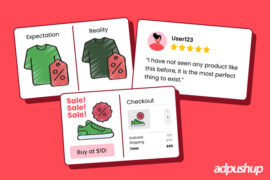

Give me six hours to chop down a tree and I will spend the first four sharpening the axe.
— Abraham Lincoln
On the surface, web publishing seems like an easy task, especially with the new generation of content management systems that do all the legwork for you. However, anyone who’s worked with websites for a long enough time will tell you that it’s not foolproof, let’s say:
- You need to change the font size
- You need to add a call-to-action
- The site crashed and you need to restore it
- The new theme is great but the red border is horrible
- A plugin is breaking your site
- You need to migrate your site
- You need to add code snippets for added functionality
- Your traffic is great but ad revenue is dismal
- You want to A/B test your ads but don’t know how
- You would like to serve your own ads
- This can go on…
All these issues are pretty common, you need to learn a little more than the basics to tackle them effectively. Keeping this in mind, here are a few core technologies that underlie every single web page you see on the internet, and how to learn them.
HMTL & CSS
HTML is the standard markup language and the foundation upon which most of what you see on the Internet is built, this along with CSS (cascading style sheets), which provides the additional visual layout for pages — forms the two core technologies for building web pages.
What exactly is markup?
Markup refers to the sequence of characters or other symbols that you insert at certain places in a text or word processing file to indicate how the file should look when it is printed or displayed or to describe the document’s logical structure. The markup indicators are often called “tags.”
For instance, let’s say you want to present something in bold. In HTML, you do this by adding the <b> tag.
<b>This text will appear in bold when rendered on page</b>
Obviously, there are many more tags, elements, and rules that come together to make even a simple web page, but this addition of tags (“markup”) is the basic idea.
Here are a few resources that you can use to get started:
- HTML & CSS, design and build websites, by John Duckett
- HTML & CSS, Codeacademy
- HTML and CSS Tutorials, w3schools
JavaScript & jQuery
Alright, so you learnt HTML and CSS and put together your first web page, congratulations!
But hey, what’s a user supposed to do with a static page? Those belong in 1998.
This is where Javascript comes in; as a full-fledged dynamic programming language, JS helps provide interactivity to HTML pages, some examples of this include: Games, responses when buttons are pressed or data entered in forms, dynamic styling, dialog boxes, and animations.
jQuery, on the other hand, is a framework for writing JavaScript “tasks” in an easier way than using plain JavaScript for the same purpose. JQuery is written in JavaScript.
Putting together HTML, CSS, JavaScript and jQuery, you have the “front-end”—things that users see and interact with on the web. These are the languages that web designers use to create modern web pages and websites, once you’ve reached a level of proficiency in them, you’ll be able to work much more easily with both pages and content management systems—creating pages, making functional and stylistic changes, and basically being able to see what’s under the hood.
Here are a few resources that you can use to get started:
- JavaScript & JQuery, interactive front-end development, John Duckett
- JavaScript, learn web development, Mozilla Developer Network
- jQuery Learning Center
Tip: Yomesh Gupta, software engineer at AdPushup, has some advice, suggested learning pace, and more resources for front-end learners:
As a publisher, your website is your most loyal and most dedicated employee. It promotes you 24/7 and always add value to your business. So, it is extremely important that it looks as neat as possible and this is only possible if you know the means and tools to do it. Hence, learn front-end development and make great products!
- Recommended pace: 2-3 hours / day
- Expected time to proficiency: 1 month
- Learning resources: www.udemy.com, www.lynda.com, www.css-tricks.com, code.
tutsplus.com
PHP
So, now you know how web pages are construction and how interactivity is built into them, but what about the stuff that goes on in the background—requesting, fetching, and serving files, performing calculations, database management, and internal logic control?
You know that thing that coders and hackers busy themselves with: Back-end development.
PHP is a server side programming language. When a user requests a web page that contains PHP code, the code is processed by the PHP module installed on that web server. The PHP pre-processor then generates HTML output to be displayed on the user’s browser screen.
— WPBeginner
Most designers know a bit coding, most coders can take a hack at a bit of designing, but few are exceptional at both, which is understandable because there is a lot to learn beyond the basics in both front- and back-end development.
By the way, PHP is not the only programming language used for back-end web development, there are others such as Node.js and Python, but PHP is a good place to begin; case in point, WordPress, the most widely used content management system in the world, is built on PHP, and so is its huge plugin ecosystem.
The world’s largest social network, Facebook, is also built using PHP, which should give you an idea about its depth, usefulness, and scalability.
To be fair, you don’t necessary need to learn PHP to use your content management system since that is the entire point of one: They do the work for you; still, you’ll do well by learning it if you’re interested in building plugins, making custom changes to your website, or if you’re simply curious about how things work.
Here are a few resources that you can use to get started:
- What is PHP?, What can PHP do? and introductory tutorial at php.net
- The Joy of PHP: A Beginner’s Guide to Programming Interactive Web Applications with PHP and mySQL, by Alan Forbes
- PHP 5 Tutorial by w3schools
Ad Operations
Maximising ad revenue is one of the most important goals of any serious web publisher, and understanding how ads work on the internet—how they are served and managed—is the first step to optimizing your own ad setup for greater success. A basic understanding of the front and back-end languages mentioned above will give you the foundation you need to really understand the mechanics of how ad operations work.
How much you need to know obviously depends on your traffic and scale of your operation: If you’re happy with just signing up with an AdSense account and putting up a few ads in random positions without testing ad layouts and positions, maybe you don’t think to think about this too much.
If however, you use multiple ad networks, use an ad server, sell your inventory directly, employ newer optimization techniques such as header bidding, or any combination of those things—learning about ad operations might well be worth your time just in terms of the potential increase in ad yield.
We recently published a post that lists some of the best learning resources for learning about ad operations, summarised here:
- AdExchanger
- Digiday
- Ad Ops Insider
- AppNexus Industry Reference
- Ad Tech Weekly
- Thalamus news aggregator
Do check the post for more interesting links and podcasts.

Shubham is a digital marketer with rich experience working in the advertisement technology industry. He has vast experience in the programmatic industry, driving business strategy and scaling functions including but not limited to growth and marketing, Operations, process optimization, and Sales.










